|
The 1861 capture
of the Salvor
Prelude to Capture - The Salvor seen
as essential property by the Union Army.
|
During the Civil War, the Union Navy sought to cripple
the Confederacy with a blockade of southern waters. In
Florida, this task fell primarily to the East Gulf
Blockading Squadron, whose mission was to deprive the
South of vital food and supplies by capturing blockade
runners and raiding salt works.
After the blockade of Tampa in 1861, Charlotte Harbor
became the only port in South Florida accessible to
runners. Consequently, this harbor became a rendezvous
point for runners and an important target for the
Union Navy. During the war, many kinds of sail and
steam-powered craft plied the deep waters of the
Charlotte Harbor region, where they operated as
blockade runners, blockaders, supply ships, and
tenders. The Salvor exemplified one type of commonly
used ship.
The
450-ton screw-steamer Salvor was possibly the first
blockade runner to operate at Charlotte Harbor and the
first to be seized and converted to Union service.
Built in 1856 in Buffalo, New York, the craft began
its career as a wrecker on the Great Lakes.
In
1860 in Chicago, McKay purchased the steamer to
transport South Florida’s beef cattle to Cuba. In New
York, McKay had the ship cut in half and 70 feet in
length added to its middle section. The Salvor’s new
length ideally suited it for duty as a cattle boat. At
161 feet in length, and with a 25 ½ ft. beam (width),
the steamer could carry as many as 300 cattle in its
dark and expanded hold. With its 19-foot draft, the
Salvor could navigate the deepest waters of the Gulf
of Mexico, Tampa Bay, and Charlotte Harbor with ease.
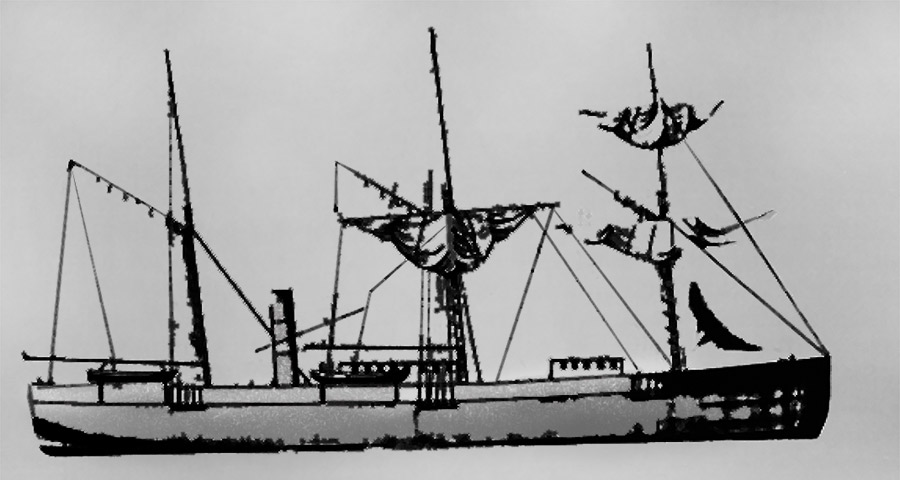
Image of the Salvor courtesy of
Naval Historical Foundation, Washington DC.
Square-rigged, the steamer sported masts that towered
above its wooden decks. These carried auxiliary sails,
clouds of canvas that helped assure the ship would
never lie dead in the water in case of engine failure.
Even the ship’s older wood and soft-coal burning
engines proved advantageous to Florida duty. This fuel
was much easier to obtain in Florida and Caribbean
ports than the hard anthracite, or Cardiff, smokeless
coal preferred by top-class northern ships. The
steamer's single gun, though not powerful enough to
intimidate warships, did prove a deterrent to pirates
and smaller, hostile craft.
In the
summer of 1860, the steamer failed to arrive on time
from the process of being modified in New York.
At the cattle holding pens at Ballast Point, some
thousand cattle perished because of a local drought,
causing a financial disaster for McKay. In
November 1860, the Salvor’s base of operations shifted
to Charlotte Harbor, where the steamer loaded cattle
from McKay’s new wharf, near present-day Punta Gorda.
Soon
the Salvor saw nearly continuous service. In January
1861, McKay purchased 10,000 head of cattle from a
south Florida rancher and shipped many of them to
Cuba. The captain, realizing that war was imminent,
had also agreed to supply cattle to the Federal forces
in Key West while continuing to sell beef in Cuba.
News of the Confederate attack on Fort Sumter in April
1861 led McKay to believe the Cuban cattle trade was,
at least temporarily, doomed. He attempted to sell the
Salvor to the Confederate Navy, but a southern naval
officer who inspected the ship at Tampa Bay rejected
the purchase after he rated the steamer too large to
work on the rivers and too slow to evade Yankee
warships at sea.
Undaunted, McKay loaded more cattle aboard the Salvor
and steered a risky course for Havana.
The
above is from Steamers, Tenders, and Barks: The
Union Blockade of South Florida by Irvin D.
Solomon and Grace Erhart, Tampa Bay History magazine,
18/02, Jan. 1, 1996 at
USF Scholar Commons
McKay
gives a detail of his version of the events up until this point in
time in his Dec. 7 letter to Gen. L. Thomas from
confinement at Ft. Taylor, Key West. Here he
describes the various times he went out of his way, by
his own expense or at a loss, to help the U.S.
Government with the Salvor. One such event was
to rescue a Union Lieutenant and his men who were
slowly drifting out to see. It caused McKay to
be labeled as a Union sympathizer by his Tampa
enemies.
McKay wrote:
This act of mine
was carried to my enemies in Tampa and noted against
me.
When asked to supply
3 heads of cattle by the Union quartermaster at
Tortugas, McKay obliged. He wrote:
This was another
heinous act of me and capital for my Tampa enemies.
These acts of mine came to their ears in Tampa.
They enlarged upon it, as I was never there, and
spread around the country that I was carrying cattle
from Charlotte Harbor to Havana, and then putting
the Spanish flag on my boat, carried the same cattle
back and sold them to the US Government at Tortugas
and Key West, and that I was a general agent for the
Government and a traitor and should be hung.
These reports were spread extensively without my
knowledge.
Major French is
Brevet Major, US Army, William H. French, commander at
U.S. Army Headquarters at Ft. Taylor in Key West.
Excerpt from McKay's
Dec. 7 letter from Ft. Taylor, Key West, to Gen. L.
Thomas in Washington, DC.:

See larger
|
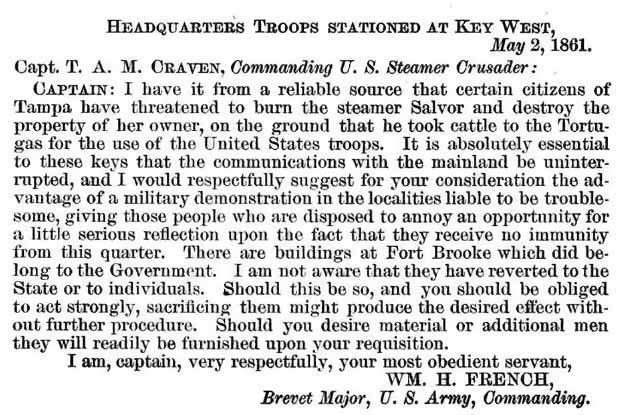
This May 2,
1861 letter from U.S. Army Maj. William H. French, commander
at headquarters at Ft. Taylor, Key West, to the Captain of
the USS Crusader, mentions the harassment of McKay by rebels
suspicious of McKay's loyalty, and suggests to Craven
...the
advantage of a military demonstration in the localities
liable to be troublesome, giving those people who are
disposed to annoy, an opportunity for a little serious
reflection upon the fact that they receive no immunity from
this quarter.
He encourages Craven to
"sacrifice" some of the buildings at Ft. Brooke by a show of
military force.
Maj. French
sought to protect the Salvor as it was essential for their
use in the Florida Keys to keep communication with the rest
of Florida.
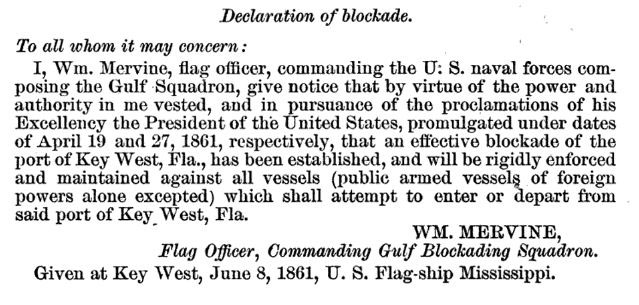
Captain
McKay, Sr. had been engaged in a profitable shipping
business using his steamer Salvor to supply his cattle
from Peas Creek near Tampa to Havana, and to U.S. troops
in Key West and the Tortugas, until prohibited by the
onset of the blockade.
Unfortunately
for McKay, when Major William H. French, commander at
headquarters, Ft. Taylor in Key West, learned of McKay's
attempt to sell the vessel to the Confederate Navy, he
ordered it seized the next time it was at Key West.
|
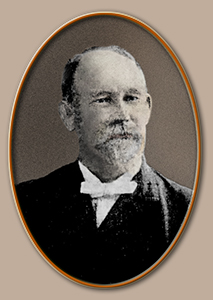 By James
McKay, Jr. in "Reminiscences
- History of Tampa in the Olden Days" Dec. 18,
1923 By James
McKay, Jr. in "Reminiscences
- History of Tampa in the Olden Days" Dec. 18,
1923
The S. S. Salvor was offered to the Confederate government
and Commodore Hartstene was sent here to inspect her. She
made a trip down the bay with him and when he returned he
told my father that she would not do for the government, as
she drew too much water for inside work and was not fast
enough for outside work.
So having two or three loads of cattle on hand, she
continued freighting them to Havana. On her last trip he
received a tip that when she returned to Key West from Tampa
she would be seized by the federal government, but as there
were a great many southern sympathizers in Key West who were
anxious to get away to the main land, he offered the Salvor
to take them to Cedar Keys, obtaining permission from the
commanding officers to do so. One hundred and eighty-six
boarded her, and he made the trip to Cedar Keys with them
not charging a cent. On the return trip he came by Tampa,
loaded cattle and returned to Havana.
Article at
right in the Peninsular in Tampa:
The Salvor and the Weir arrived in Tampa bringing
secessionist citizens ("loyal citizens of the State") from
Key West who were being treated "badly" by the military.
The election mentioned in the article took place in Key
West. News from July 8 below indicates the Salvor
returned to Key West.
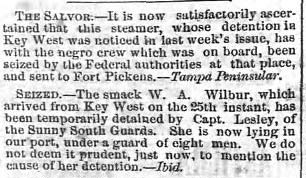
See McKay Sr's
Dec. 7 letter further down to Gen. L. Thomas from
confinement at Ft. Taylor, Key West, which gives detail
about this voyage and CSA Capt. Hartstene's inspection of
the Salvor. McKay says he collected $180 from the
passengers, but the trip cost him $300.
July 8, 1861 -
Savannah Republican
Reports from the Tampa Peninsular the Salvor detained at
KW and sent to Ft. Pickens, Lesley's Sunny South Guards
detain the W.A. Wilbur.
|
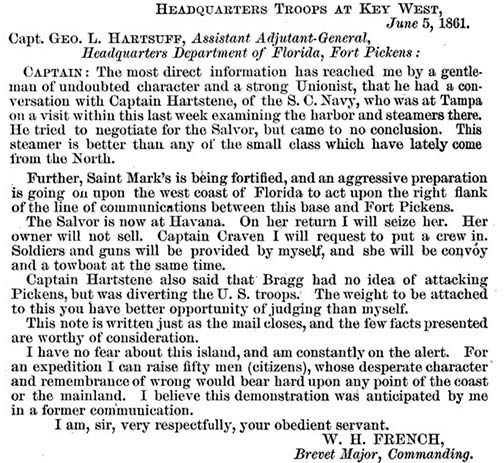 |
|
Letter
from W.H. French at Ft. Taylor, Key West to Capt.
Hartsuff at Ft. Pickens, June 5, 1861 |
After seizing the Salvor at Key West,
the Federal troops there immediately retrofitted it and
pressed the ship into their own service. The steamer was
employed by the U.S. Navy quartermaster's department, making
trips to Ft. Pickens and to the Tortugas, being used by the
government for three months.
Running
constantly in salt water burned out her boilers so Maj.
French had a survey made on her by Asst. Quartermaster and
Engineer Grier of the US steamer Crusader. He reported
the Salvor unsafe and unfit to go to sea, so she was then
anchored under charge in Key West Harbor.
The War of the Rebellion: v. 1-53 Formal reports,
both Union and Confederate, of the first seizures of United
States property in the southern states, and of all military
operations in the field, with the correspondence, orders and
returns relating specially thereto. 1880-98.
|
Several months
later, in Feb. 1862, a friend of McKay's, L. D.
Stickney, would write about these events in a letter, an
excerpt of which is shown here, to Sec. of State William
Seward in defense of McKay. Stickney was a tax commissioner
to Florida, an appointee and friend of Secretary Chase of
the treasury department.
When I first made the acquaintance of Captain McKay
in May
[1861]
last he was shipping cattle from Florida to Havana,
Cuba. He was generally regarded as the most
enterprising man in that State as well as one of its
wealthiest citizens. A few weeks later I met him in
Key West. He was there with his propeller the Salvor
when Flag-Officer William Mervine arrived to enforce
the blockade of the Gulf ports of the Confederate
States.
By order of Flag-Officer Mervine the Salvor was
seized, but subsequently she passed into the charge
of the quartermaster's department of the Key West
military division and made one or two trips to
Tortugas and Fort Pickens. Her boilers being
defective the quartermaster declined to make any
further use of the Salvor and she was moored in Key
West Harbor.
|
McKay
gives a detail of the events up until this point in
time in his Dec. 7 letter to Gen. L. Thomas from
confinement at Ft. Taylor, Key West:
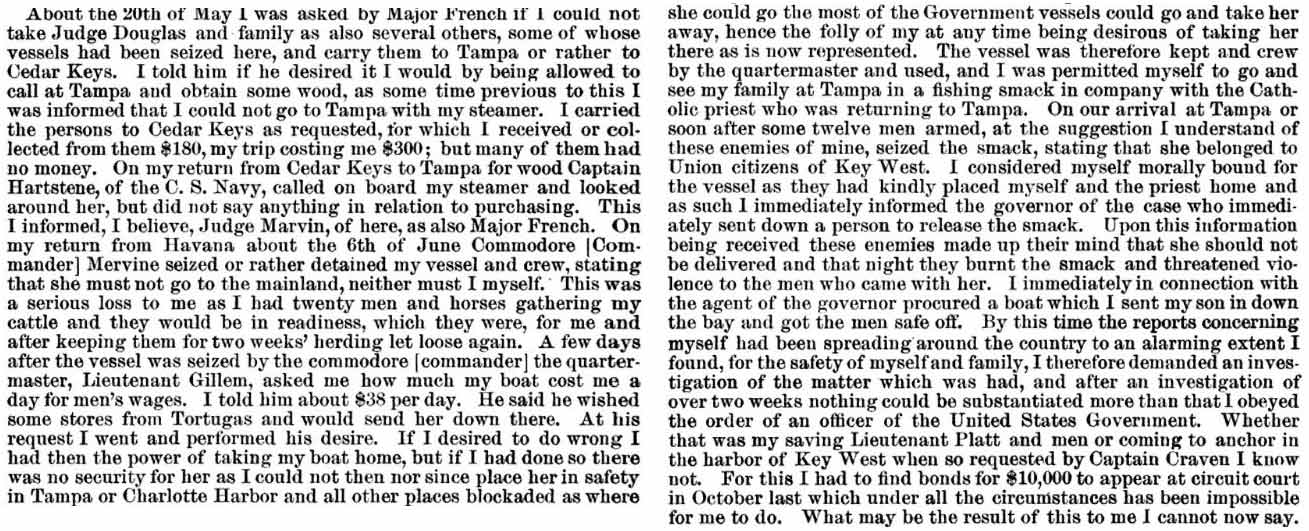
See larger
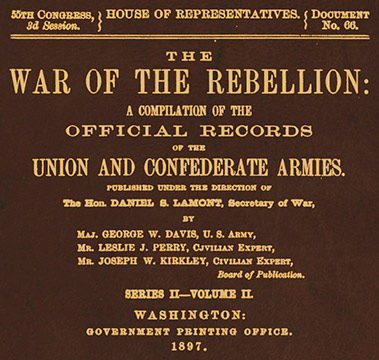
Most all of the information and images
of correspondence in the rest of this section, and the above
letter of McKay in sections, are from
The War of the Rebellion: A Compilation of the Official
Records of the Union and Confederate Armies, pub 1897
1861 - August - The Salvor breaks down in Havana
In late August
of 1861, the Asst. quartermaster at Key West had the
occasion to procure horses from Havana and informed Maj.
French that Capt. McKay suggested his steamer would be able
to go to Havana and return with the horses. This they
attempted, but a week later the quartermaster returned to
Key West and reported that the steamer had broken down and
could not be repaired for some time. The Salvor
remained in Havana, but the horses were purchased and
arrived in Key West a week later.
The steamer was
then turned over to McKay for repairs on the condition that
he would not take her into any port in the hands of the
insurgents or perform any service for them.
Ever the
optimist, McKay offered his reclaimed ship to the U. S.
Government. The Federals, however, had little use for the
crippled ship, and McKay collected around $1,000 in lease
fees for its limited service.
|

As he passed through Key West, the commanding officer
notified my father that an officer would go with him to
Havana to purchase animals for use of the military at Key
West and for him to follow his orders. On arrival at Havana
the crew refused to return to Key West and the ship was laid
up. The officer was informed to get back to Key West the
best way he could.
by James
McKay, Jr. in "Reminiscences
- History of Tampa in the Olden Days" Dec. 18,
1923
|
|
An excerpt from
L. D. Stickney's Feb. 1862 letter:
About the 1st of August Captain McKay came from
Tampa to Key West with a flag of truce. In a
conversation I had with him at that time he
expressed disgust at the Confederate rule in Florida
and added that he desired to remove his family to
some place within the jurisdiction of the United
States, dispose of his property at Tampa and
vicinity and turn over the Salvor to the Government
of the United States. Shortly after this
conversation with Captain McKay, the Salvor sailed
for Havana in charge of Quartermaster Webber for the
purpose of bringing back a lot of horses. Mr. Webber
returned four or five days afterward in a fishing
smack without the horses.
|
1861 - Oct. 14 - The Salvor captured while running the
blockade
McKay gave
his word that he would not attempt to run the blockade again
and sailed the disabled Salvor to Cuba. He expected to sell
the steamer to a Cuban bidder, but the buyer had withdrawn
his offer by the time McKay reached Havana. Hoping to sell
the steamer and a contraband cargo at Nassau, McKay had the
Salvor’s boiler repaired and readied for the voyage across
the Straits of Florida. He also changed the ship’s name to
M.S. Perry and transferred title to a British subject, Mr.
John McLenan, so the ship would have foreign registry and
would, theoretically, be safe from capture by the Federals.
On October 13, 1861, McKay set off for Nassau with a cargo
of small arms, percussion caps, coffee, and cigars. This
would prove to be the Salvor’s final voyage under his
command.
|
 James McKay,
Jr. revealed what really happened: James McKay,
Jr. revealed what really happened:
My father chartered a fishing smack to bring him to Tampa,
as he wished to ascertain the situation in the south.
Secretary S. R. Mallory who was a great friend of his,
advised him to run the blockade with the Salvor. The south
would go to war and they
[the Rebels]
wanted arms and ammunition.
So my father returned to Havana, obtained a cargo of guns
and other war materials and merchandise, induced some of his
Cuban friends to invest in the enterprise, which they did,
the cargo costing some $400,000.
Clearing the ship for Nassau, under the English flag, but
actually bound for Cedar Keys, he sailed out of Havana
harbor in the afternoon towards Nassau, but when night came
on, changed the course for Cedar Keys.
by James
McKay, Jr. in "Reminiscences
- History of Tampa in the Olden Days" Dec. 18,
1923
|
Although
supposedly repaired, the steamer’s engines propelled it
along at a modest 3 ½ miles per hour. Every two hours the
engines had to be shut down for servicing. The limping
ship proved no match in speed for a Federal warship. While
attempting to run the blockade under the English flag, the
M.S. Perry, f.k.a. Salvor, was captured about twenty miles
south of the Tortugas on the 13th of October, 1861 at about
11pm by commanding Captain Scott U.S. Navy of the steamer
USS Keystone State.
(Read about Ft. Jefferson on the Tortugas)
|
An excerpt from
L. D. Stickney's Feb. 1862 letter:
The Salvor remained
[in
Havana]
and subsequently I learned from Mr. Thomas Savage,
vice-consul-general at Havana, that Captain McKay
sold her to British owners and her name was changed
to the M. S. Perry.
While sailing under British colors the Perry was
captured by the U. S. steamer Keystone State, Capt.
G. H. Scott. Captain McKay and his son Donald, a
mere boy, were on board.
|
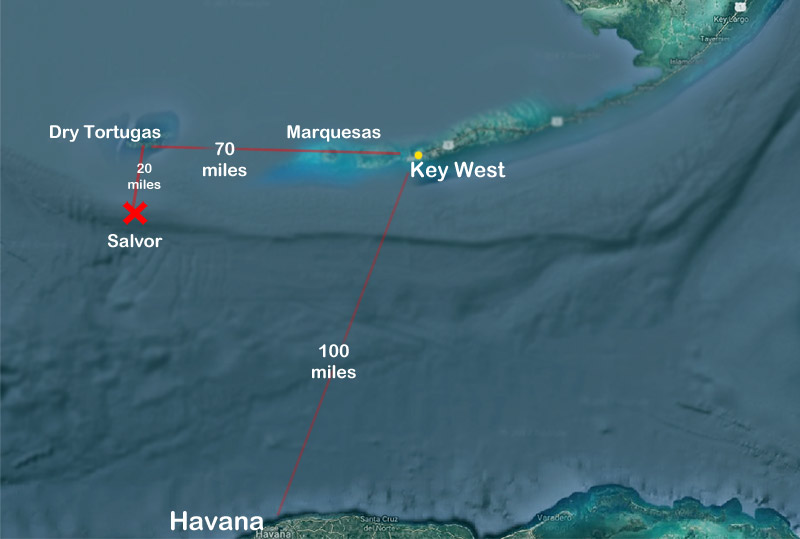
|
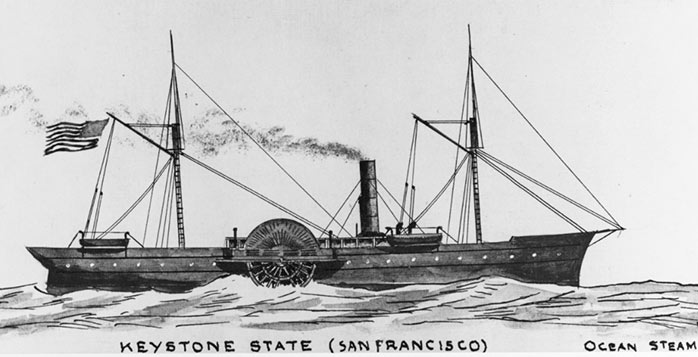 |
|
This
steamer served as USS Keystone State
in 1861-65.
After the Civil War she returned to civilian use as
San Francisco. Courtesy of Erik Heyl.
(American Steamship 1853-1879) Watercolor by Erik Heyl,
1949, painted for use in his book Early American
Steamers, Volume I.
U.S. Naval History and Heritage Command Photograph. |
McKay
gives a detail of the events leading up to and
including the Salvor's capture in his Dec. 7 letter to
Gen. L. Thomas from confinement at Ft. Taylor, Key
West:
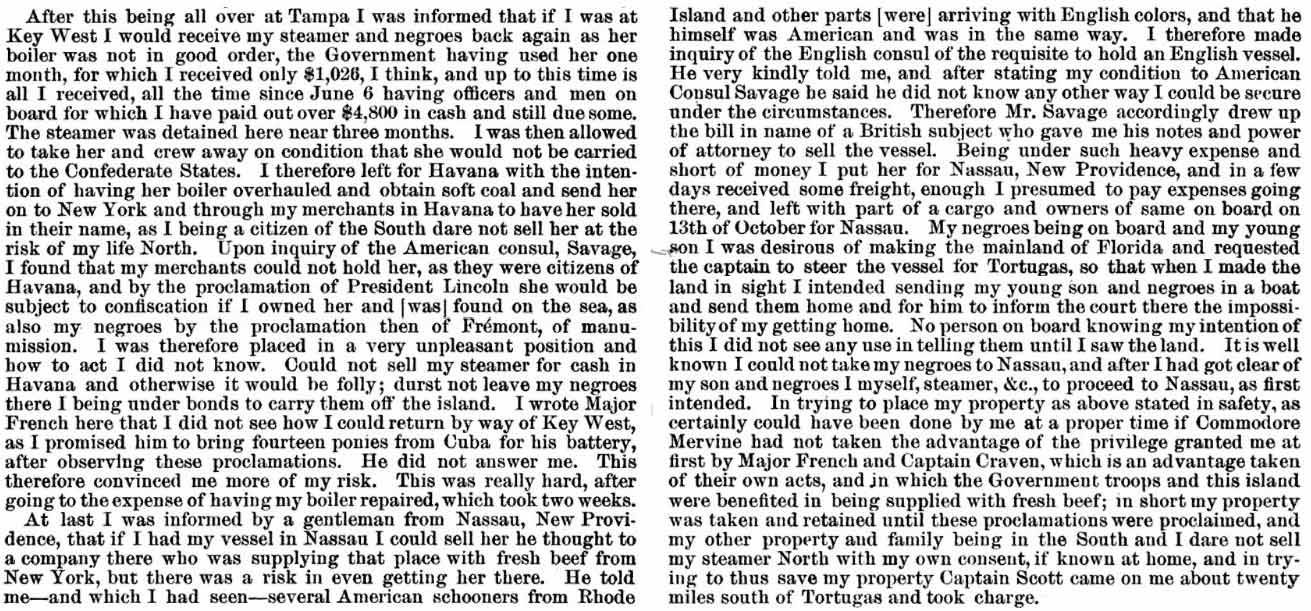
See larger
The vessel,
along with McKay, his 15-year-old son Donald, his crew, and
two passengers, were taken to Key West to be detained at Ft.
Taylor, arriving at sunrise on Oct. 14.
Those taken
into custody were James McKay Sr. as owner of the Salvor,
and passengers Mr. Ball and Dr. Barrett. Afterward,
Charles Tifft, merchant of Key West, was arrested for
funding McKay's voyage. These four were detained at
Ft. Taylor while the others, Donald McKay, 15-year-old son
of James McKay Sr., Captain Francisco "Ponche"
Menendez, First Officer J. Charles Butler, First engineer
William J. Browning, Asst. engineer George McNabb, cook
Hunter Semple, crewmember seaman William Reed,
crewmember seaman Frederick Lewis , crewmember seaman Peter
Fernandez , crewmember seaman Don Santos, and possibly a
crewmember seaman David Evans, were all held on the USS
Keystone.
Brevet Major,
US Army, William H. French boarded the Salvor and
"...found
the evidences* so strong against her and against all on
board that I sent the officer of the day to arrest
[James]
McKay and the two passengers named Ball and Dr.
Barrett."
*Various
sources give differing accounts of the contraband on the
Salvor. In "MEN, SALT, CATTLE AND BATTLE" THE CIVIL
WAR IN FLORIDA (November 1860 - July 1865) by William J.
Gladwin, Jr. Commander, USNR, Naval War College - Newport,
RI, June 1992, which is chronology of the Civil War events
in Florida, the author states:
"U.S.S.
Keystone State, Commander Gustavus H. Scott, captured
Confederate steamer Salvor, commanded by James McKay of
Tampa, near the Tortugas Islands with cargo of coffee,
cigars, 21,000 stands of arms, 100 boxes of revolvers, 6
rifled cannon and ammunition. (CWNC: pg 1-29: WOR; Ser I,
Vol 6, pg 308)"
|

The next day he was captured by the Keystone State and towed
to Key West. My father was confined in Fort Taylor and the
steamer, with my brother, Donald, and the crew taken to
Philadelphia. Donald was sent to Fort Lafayette, N. Y.
harbor. Seven of the crew, being negroes owned by my father
were freed. The steamer was sold and purchased by Clyde and
Company. The cargo was also sold.
by James
McKay, Jr. in "Reminiscences
- History of Tampa in the Olden Days" Dec. 18,
1923
|
In his lengthy
letter of Dec. 7 from confinement at Ft. Taylor to Gen. L.
Thomas in Washington, McKay detailed his cargo by memory:
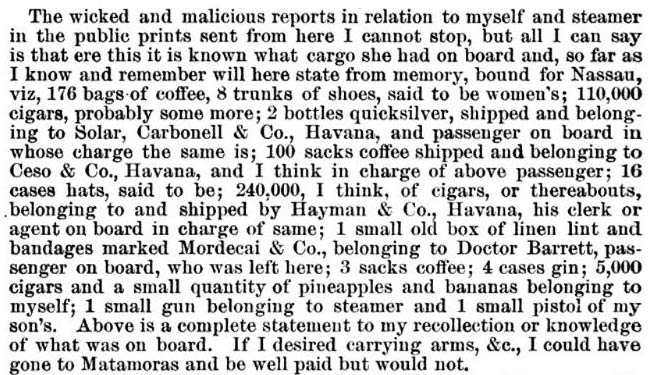
McKay lies about not
having any weapons on board, "to his knowledge."
See this
whole last page
|
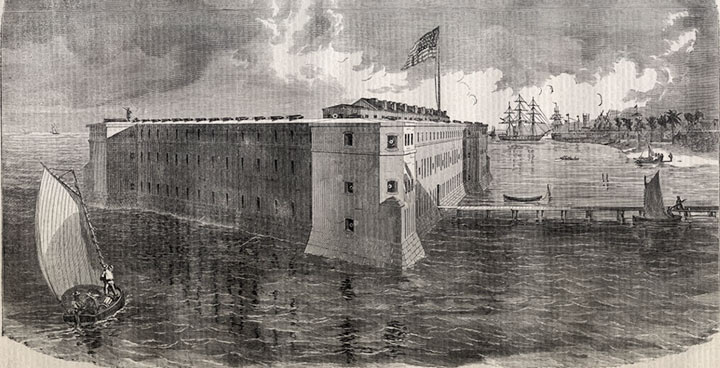 |
|
Fort Taylor,
Key West
From SonOfTheSouth.net, where they state: Civil
War Harper's Weekly, The March 2, 1861 edition of
Harper's Weekly featured a cover illustration of
president elect Abraham Lincoln. The remainder of the
newspaper includes incredible stories on the opening
events of the Civil War. We have posted the newspaper
below.
Newspaper Thumbnails will take you to the page of
interest." |
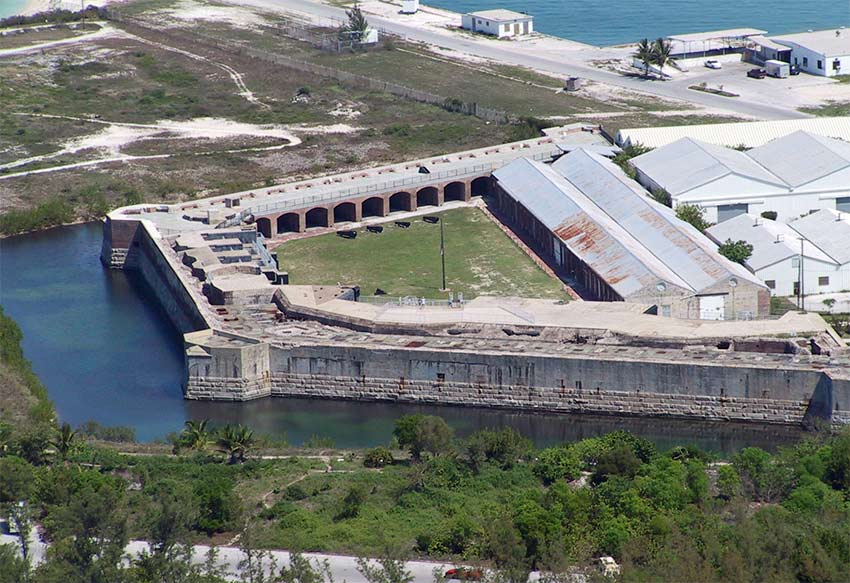
Fort Zachary
Taylor Park photo courtesy of
Charlotte Spokes People
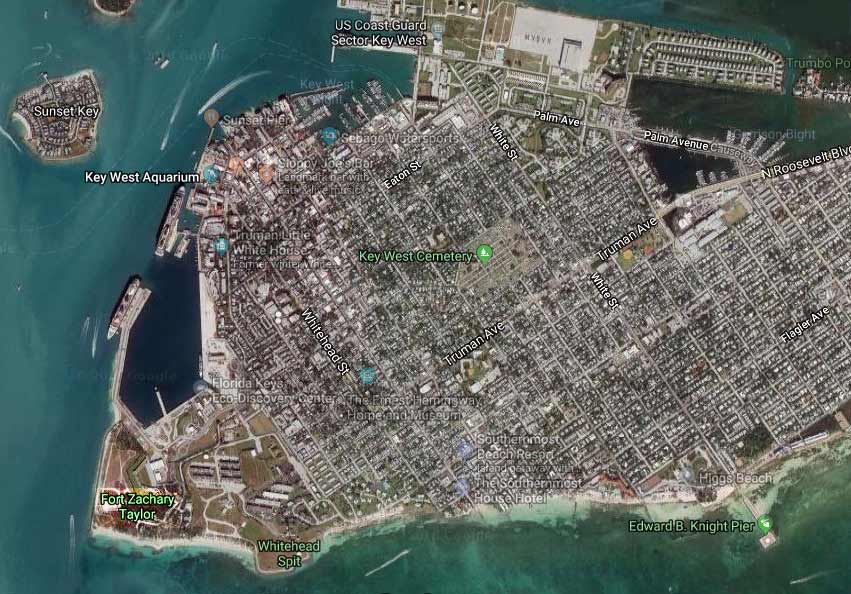
Fort Zachary
Taylor at Key West, lower left.
The U.S.
District court in Key West then asserted jurisdiction over
the case, but this was resisted by naval commander Scott of
the Keystone. He sent a note to French stating his
intent to take the Salvor for the prize courts to the North,
along with all who were captured. The note directed
French to turn over his three prisoners as prizes of war.
U.S. Dist.
Atty Thos. J. Boynton wrote to French on Oct. 16:
"There is
no doubt that the men mentioned are guilty of treason
against the Government of the United States, the offense
having been committed on the high seas. They can
only be tried in this district after having once been
brought here. It is consequently defeating the ends
of justice to take or send them to New York. In
addition to this fact, the vessel has been libeled and an
attachment regularly issued and the vessel, the Salvor, or
MS Perry, is now properly in the custody of the US
marshal. If the marshal should call on you for
assistance in keeping or regaining possession of the
prize, it is my opinion you would be justified in
assisting, but violence disproportioned to the nature of
the outrage would not of course be justifiable, such for
instance as sinking the vessel in the channel to prevent
her leaving port."
To which
French replied:
The steamer is leaving without my being able to send any
letters of advice or explanation.
French declined
Capt. Scott's request to turn over the three prisoners and
contrary to the wishes of the judicial authorities, Capt.
Scott left for Philadelphia on the Keystone, with only two
hours notice, and the M.S. Perry (a.k.a. Salvor) in tow,
along with its crew, McKay's slaves, and McKay's young son,
for trial in the prize courts.
See Maj.
French's assessment of the situation in his
Oct. 17 letter
to Brig. Gen. L. Thomas in Washington DC.
Slaves
onboard the Salvor
This letter of
Oct. 31, 1861 from Sec. of State William H Seward to
Gideon Welles, Sec. of the Navy mentions slaves which were
onboard the Salvor, but doesn't say how many there were;
only that they were to be retained at the Navy yard at
Philadelphia where the Salvor remained, "for such service
as they can be usefully employed upon..."
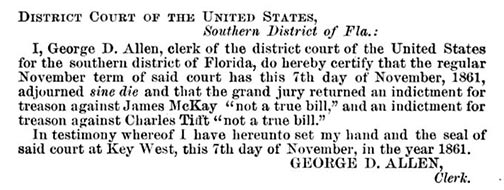
1861-Nov. 7 -
Indictment for treason overruled
The grand jury
of the district court of the US for the Southern district of
Florida, regular November term, on the indictment for
treason against McKay, returned a "not a true bill" decision
on Nov. 7, 1861, primarily because the evidence had been
taken north with the Salvor by Capt. Scott of the Keystone.
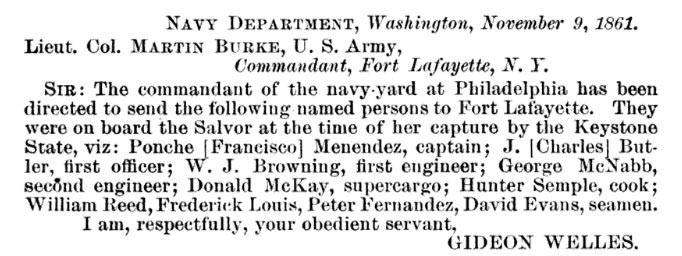
1861-Nov 9 -
Prisoners sent to New York
On Nov. 9,
1861, those being held at the Navy yard in Philadelphia were
ordered to be sent to Fort Lafayette; prison off the coast
of the Bronx, New York.
Info and images of letters used above
are mostly from
Congressional Edition, Volume 3788
|
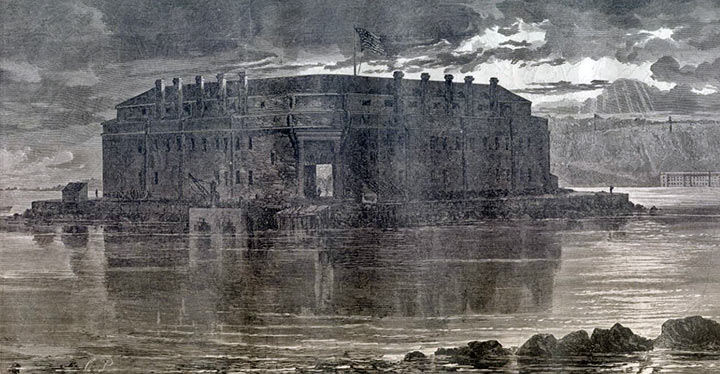 |
|
Fort Lafayette
was an island coastal fortification in the Narrows of
New York Harbor, built offshore from Fort Hamilton at
the southern tip of what is now Bay Ridge in the New
York City borough of Brooklyn. The fort was built on a
natural island known as Hendrick's Reef. Construction
on the fort began during the War of 1812 and was
completed in 1822. The fort, originally named Fort
Diamond after its shape, was renamed in 1823 to
celebrate the Marquis de La Fayette, a hero of the
American Revolution who would soon commence a grand
tour of the United States.
Wikipedia photo from Harper's Bazaar magazine, Sept 7,
1861
The fort was demolished in 1960 to make room for the
Verrazano-Narrows Bridge; the Brooklyn-side bridge
tower now occupies the fort's former foundation site.
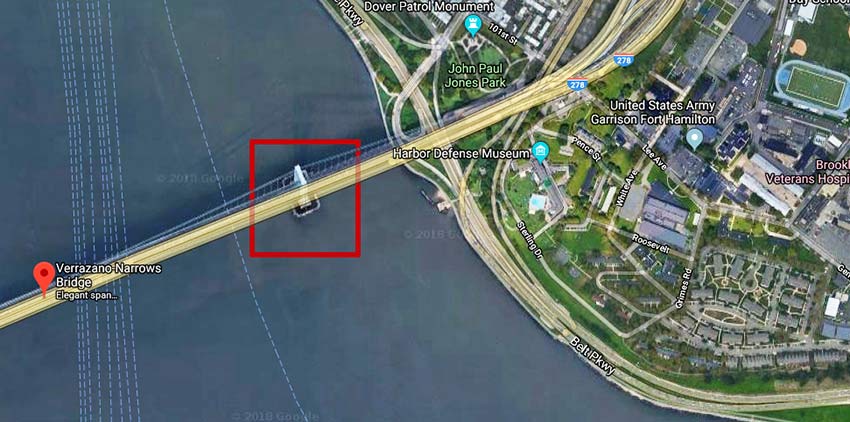 |
|
Donald McKay at Fort Lafayette
Asst.
Sec. of State F.W. Seward's letter to William
Lighthall, Esq. of New York, stating Donald McKay
should not be released yet, but he was to be furnished
with "any articles which may be necessary for his
comfort." |
 |
|
Donald McKay's Dec. 2, 1861 letter written from
prison at Fort Lafayette, to Sec. of State William H.
Seward. |
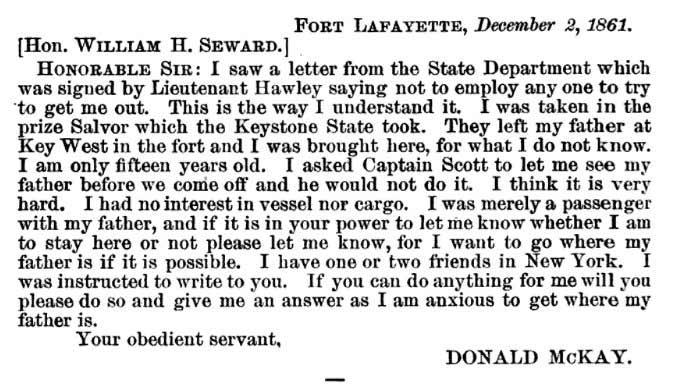 |
1861-December 7 - McKay's lengthy appeal from Fort Taylor
to Adj. Gen. L. Thomas, Washington DC
Lengthy letter (links below) from McKay to L. Thomas,
Adj Gen. US Army, Wash DC. giving his side of the story:
Pg.1 -
Pg. 2
- Pg.3
- Pg.4
- Pg.5
1862-January -
McKay' release
at Fort Taylor,
Key West
By a letter on
Jan. 23, 1862, to Sec. of State Seward from Maj B.H. Hill at
Ft. Taylor, Key West, , Seward was advised that McKay had
been released from military custody in Key West and would
proceed on his pledge to New York and then to Washington and
report himself to the Sec. of State.
|
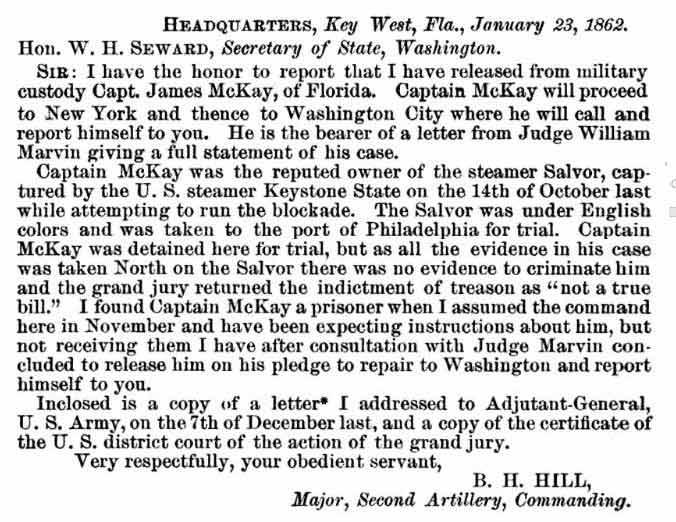 |
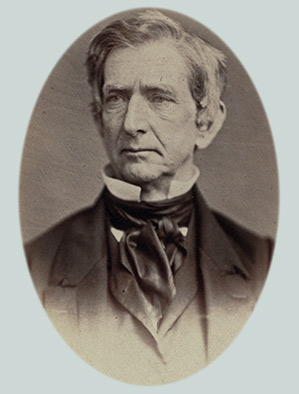 |
|
Secretary of
State Wm. H. Seward
Seward orchestrated the purchase of the Alaska
territory which was deemed "Seward's Folly" in its
time. He was also victim of an assassination
stabbing attempt by a co-conspirator on April 15, 1865
when President Lincoln was assassinated. |
|
|
|
|
The rest of L. D. Stickney's Feb. 11, 1862 letter to Sec. of
State Seward
Having been driven from my own property by the
rebels for furnishing some cargoes of timber to
complete the defense of Fort Taylor and residing in
Key West from July to December last, where I had an
opportunity of observing what was transpiring, I
have no hesitation in saying that whatever Captain
McKay's offenses may be greater blame attaches to
the U. S. officials who governed that post than to
him. They were, with the exception of Mr. Charles
Howe, collector; T. J. Boynton, U. S. attorney; E.
B. Hunt, captain of U.S. Engineers, and Captain
Brannan, greater favorites with the rebels than
loyal citizens. If instead of Major French such
officers as General Banks or Butler or the present
commander, Major Hill, had had the direction of
military affairs at Key West, nearly all would have
returned to their allegiance, whereas three-fourths
by the example and conduct of those highest in,
authority were in open, active hostility to the
United States Government.
Captain McKay, stripped of his large property,
crushed in spirit, but as he assures me loyal in
heart to the Union, certainly deserves to have his
case speedily disposed of, and I am sure it will be
your pleasure to deal as leniently with him as with
others who have experienced your clemency. He is
illy able to bear the expense of delay in Washington
and I earnestly hope you will give him a prompt
hearing. I am known to Hon. C. B. Smith, William
McKee Dunn, E. P. Walton and George D. Prentice,
Esq., who will vouch for my loyalty.
With high regard, your admirer and friend, L. D.
STICKNEY.
|
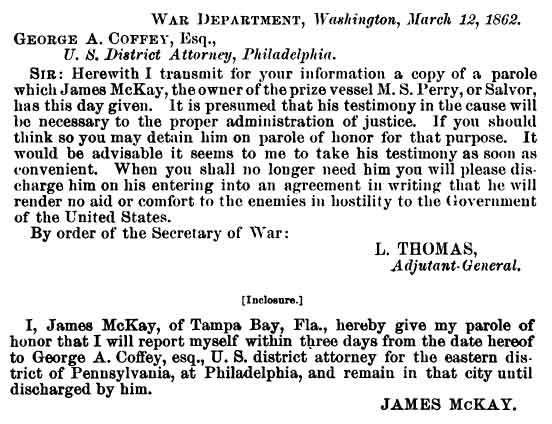
James McKay in Philadelphia and release
McKay arrived
in Philadelphia around Feb. 1, 1862. On Feb. 15,
in accordance with the order of the War Dept. of the
preceding day he was transferred to the charge of that Dept.
On Mar 12, Adj
Gen L. Thomas of the War Dept. in Washington DC advised the
US Dist. Atty in Philadelphia, George Coffey, that McKay's
testimony concerning the Salvor incident be taken as soon as
possible and when he was no longer needed could be
discharged on the condition he agree in writing that he will
render no aid or comfort the the enemies in hostility to the
Government of the United States.

Mar. 13, 1862
letter from Col. Martin Burke, Ft. Hamilton, NY
to Gen L. Thomas regarding Donald McKay's parole
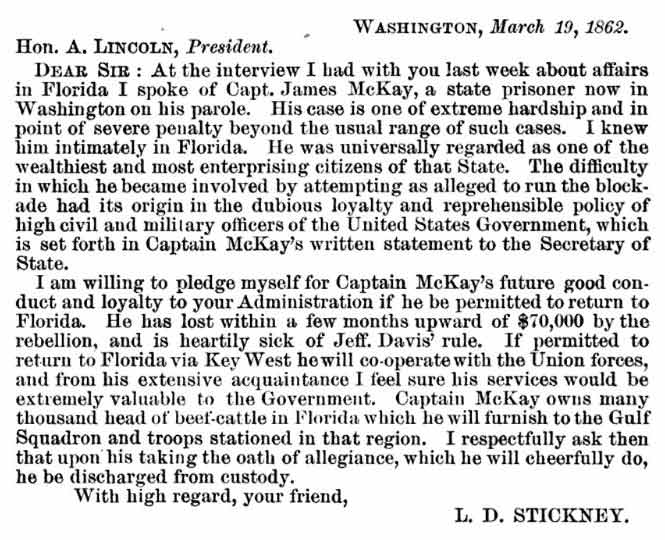
This Mar. 19,
1862 letter from L. D. Stickney to President Lincoln makes
reference to a personal visit with the President the
previous week.
McKay remained
in custody until his Oath of Allegiance was sent to
President Abraham Lincoln on Mar 20, 1862.
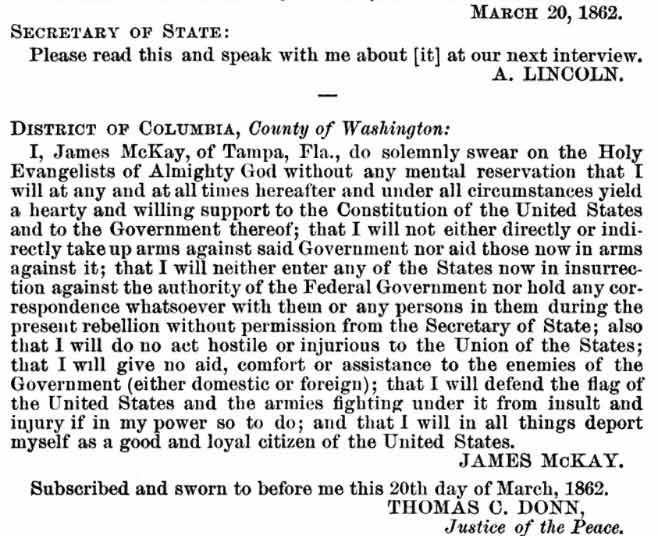
McKay was then
released and arrived back in Key West on April 21, onboard
the steamer Rhode Island, and reported to General Brannan.
In Key West, he was informed by Gen. Brannon that the
captain of the U.S. steamer Connecticut, which left Key West
the day before McKay arrived, had heard on his way to Key
West from a blockading vessel in Tampa that McKay had
written his wife from Washington to warn them that Gen
Brannon would be invading Tampa with a large force of 600 to
700 men. In his April 24
letter to Gen. Thomas, McKay denied having written his
wife concerning the impending Union attack on Tampa, and
explained how it was impossible for him to do so--his mail
would have been opened and read at Fort Monroe** in
Virginia.
**Beginning in
1862 Fort Monroe was also used as a transfer point for mail
exchange. Mail sent from states in the Confederacy addressed
to locations in the Union had to be sent by flag-of-truce
and could only pass through at Fort Monroe where the mail
was opened, inspected, resealed, marked and sent on.
Prisoner of war mail from Union soldiers in Confederate
prisons was required to be passed through this point for
inspection. If this was indeed a "one way" inspection
of mail, McKay could have written the alleged letter without
it being opened at Ft. Monroe since it was going from
Washington DC to the South.
|
The fate
of the Salvor/M.S. Perry
According to L.
D. Stickney's letter of Feb. 11 above:
The Salvor was carried to Philadelphia, condemned and sold
by the admiralty court as a prize.
On Feb. 18,
1862, U.S. Attorney George Coffey in Philadelphia wrote to
Sec. of State William Seward:
"...It is beyond my power to send the original
documents found on board of the vessel at the time
of her capture for they are in judicial custody and
cannot of course leave the possession of the court.
The case is still pending in the prize court. The
vessel has been sold under an interlocutory decree
as perishable by reason of changeableness and
deterioration resulting from her detention. A final
decree of condemnation has not yet been entered."
According
to Steamers, Tenders, and Barks: The Union Blockade
of South Florida by Irvin D. Solomon and Grace
Erhart,
USF Scholar Commons:
After sailing to Key
West, the Salvor was condemned and shipped North,
never to return to Florida waters. Later that year,
the steamer was sold at auction in Philadelphia for
$38,250.94. After the war, the ship served as a
freighter on the Metropolitan line between Boston
and New York.
|
|
The fate of McKay's slaves
At the
beginning of his lengthy letter of Dec. 7 from
confinement at Ft. Taylor to Gen. L. Thomas in
Washington, McKay thanked Thomas for sending them
back, and viewed this as being "a kindness to them as
they desired it."
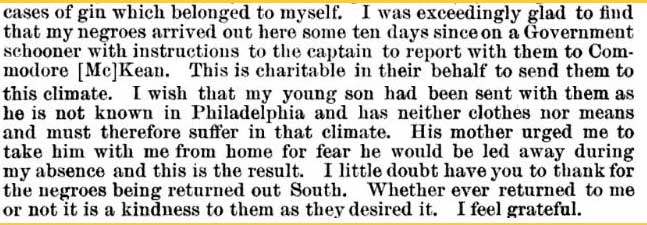
|
Table of correspondences concerning those captured on the
Salvor
Click the date links to see related correspondence detailing
the events concerning each person listed.
| Who |
Capture |
Events |
Events |
Events/Letters |
|
James McKay Sr.
Owner of the Salvor |
Captured with the Salvor, Oct. 13, 1861 |
Oct. 14,
1861 Arrested, Detained as prisoner of war at Ft.
Taylor, Key West |
Nov. 7, 1861
- Indictment for treason deemed not a true bill by
Grand Jury at Key West. |
Dec 6, 1861-From
Cmdr. BH Hill, Ft. Taylor to Adj. Gen. Wash.DC.
Dec 7, 1861-Lengthy
letter (links below) from McKay to L. Thomas, Adj Gen.
US Army, Wash DC. giving his side of the story:
Pg.1 -
Pg. 2
- Pg.3
- Pg.4
- Pg.5
Dec 7, 1861
-
From Cmdr. BH Hill, Ft. Taylor to L. Thomas Adj Gen
Wash. DC.
Jan 23, 1862-From
BH Hill, Cmndr, Key West, to Sec. of State Wm Seward
confirm McKay released from Ft. Taylor, to report to
him in Wash. DC. for trial
Feb 11, 1862-From
LD Stickney*, friend of McKay, to Sec. of State Seward
Feb 14,
1862-From FW Seward to G. Coffee, US Dist. Atty.
Phila.
Feb 18, 1862
From G.Coffey, reply to FW Seward, Asst Sec of State
Feb 19,
1862-From FW Seward, reply to G. Coffee, US Dist.
Atty. Phila.
Mar 12, 1862-From
L Thomas, Adj Gen War Dept, to G.Coffey, US Dist Atty
Phila.
Mar 14, 1862-From
Hubly Ashton, Asst US Atty Phila. to Gen L.Thomas
Mar 19, 1862-From
LD Stickney to Pres A. Lincoln
Mar 20, 1862-From
Pres A. Lincoln to Sec of State Wm Seward re: J.McKay
Oath
Apr 24, 1862
From J.McKay, free & returned to Key West, to Gen
L.Thomas re fake news
*L. D.
Stickney was a tax commissioner to Florida , an
appointee and friend of Secretary Chase of the
treasury department. |
|
Donald McKay
15-year-old son of James McKay Sr.
Passenger |
Captured with the Salvor, Oct. 13, 1861 |
Oct. 16, 1861
- Taken to the Navy yard at Philadelphia by Keystone,
Capt. Scott USN, with the Salvor |
Nov. 9, 1861-
Sent from Navy yard, Phila to Ft. Lafayette prison, NY |
Nov 12, 1861-Appeal to
British Consul in NY, from Menendez, signed by all.*
Nov. 28,
1861 - From FW Seward, State Dept to Wm Lighthall,
Esq. NY.
Dec 2, 1861
- From Donald McKay at Ft. Lafayette to Sec. of State
Wm Seward.
Feb 3, 1862-From
Robt Murray, US Marshal, NY to Sec. of State Wm Seward
Mar 8, 1862-From
L. Thomas, Adj Gen. War Dept to Lt. Col Martin Burke,
Ft. Lafayette, NY-Authorization to release.
Mar 13, 1862-From
Col. Martin Burke, Ft. Hamilton, NY to Gen L. Thomas,
Donald McKay parole |
|
Francisco "Ponche" Menendez
Spanish subject
Captain |
Captured with the Salvor, Oct. 13, 1861 |
Oct. 16, 1861
- Taken to the Navy yard at Philadelphia by Keystone,
Capt. Scott USN, with the Salvor |
Nov. 9, 1861-
Sent from Navy yard, Phila to Ft. Lafayette prison, NY |
Nov 12, 1861-Appeal to
British Consul in NY, from Menendez, signed by all.*
Jan 22, 1862-Menendez
letter to Sec. of State Wm Seward
Feb. 3, 1862
- Released by order of Sec. of State having given his
evidence before the prize court commissioners.
|
|
J. Charles Butler
First Officer, Mate |
Captured with the Salvor, Oct. 13, 1861 |
Oct. 16, 1861
- Taken to the Navy yard at Philadelphia by Keystone,
Capt. Scott USN, with the Salvor |
Nov. 9, 1861-
Sent from Navy yard, Phila to Ft. Lafayette prison, NY |
Nov 12, 1861-Appeal to
British Consul in NY, from Menendez, signed by all.*
Jan. 8, 1862 - Released. Claimed to be a subject
of Denmark and for the purpose of obtaining the facts
of his nationality was released by order of the Sec.
of State and placed into custody of US Marshal Murray
of NY. |
|
William J. Browning
First engineer |
Captured with the Salvor, Oct. 13, 1861 |
Oct. 16, 1861
- Taken to the Navy yard at Philadelphia by Keystone,
Capt. Scott USN, with the Salvor |
Nov. 9, 1861-
Sent from Navy yard, Phila to Ft. Lafayette prison, NY |
Nov 12, 1861-Appeal to
British Consul in NY, from Menendez, signed by all.*
Nov. 20,
1861-To Sec. of State Wm Seward.
Dec 13, 1861-From
Robt Murray, US Marshal at Ft. Lafayette NY to Sec. of
State Wm Seward, Wash DC
Dec 14, 1861-From
Asst. Sec FW Seward, Dept of State to Lt. Col. Martin
Burke, Ft. Lafayette NY
Dec. 17,
1861 - Released on his taking of an oath of
allegiance. |
|
George McNabb
Asst. engineer |
Captured with the Salvor, Oct. 13, 1861 |
Oct. 16, 1861
- Taken to the Navy yard at Philadelphia by Keystone,
Capt. Scott USN, with the Salvor |
Nov. 9, 1861-
Sent from Navy yard, Phila to Ft. Lafayette prison, NY |
Nov 12, 1861
George to brother James
Nov 12, 1861-Appeal to
British Consul in NY, from Menendez, signed by all*
Nov. 20,
1861-To Sec. of State Wm Seward.
Dec 13, 1861-From
Robt Murray, US Marshal at Ft. Lafayette NY to Sec. of
State Wm Seward, Wash DC
Dec 14, 1861-From
Asst. Sec FW Seward, Dept of State to Lt. Col. Martin
Burke, Ft. Lafayette NY
Dec. 17,
1861 - Released by order of the Sec. of State on
taking Oath of Allegiance. |
|
Hunter Semple British
subject
Cook |
Captured with the Salvor, Oct. 13, 1861 |
Oct. 16, 1861
- Taken to the Navy yard at Philadelphia by Keystone,
Capt. Scott USN, with the Salvor |
Nov. 9, 1861-
Sent from Navy yard, Phila to Ft. Lafayette prison, NY |
Nov 12, 1861-Appeal to
British Consul in NY, from Menendez, signed by all.*
Feb. 3, 1862
- Released by order of Sec. of State having given his
evidence before the prize court commissioners.
Feb 3, 1862-From
Semple in New York to Robt Murray, US Marshal at Ft.
Lafayette |
|
William Reed
Crew, seaman |
Captured with the Salvor, Oct. 13, 1861 |
Oct. 16, 1861
- Taken to the Navy yard at Philadelphia by Keystone,
Capt. Scott USN, with the Salvor |
Nov. 9, 1861-
Sent from Navy yard, Phila to Ft. Lafayette prison, NY |
Nov 12, 1861-Appeal to
British Consul in NY, from Menendez, signed by all.*
Dec 24, 1861-Appeal
from Reed to Hon. Lord (Richard) Lyons, British
diplomat
Dec 31, 1861-Ltr.
from Lyons to Sec. of State Wm Seward
Jan
10, 1862-Ltr. from Seward to Lord Lyons
Jan 10, 1862-Ltr.
from Seward to Ft. Lafayette Marshal Robt Murray
Jan 13, 1862-Letter from
Lt. Col. Martin Burke cmdr. Ft. Hamilton, NY Harbor,
to Sec. of State Wm Seward confirming release of Reed. |
|
Frederick Louis French
subject
Crew, seaman |
Captured with the Salvor, Oct. 13, 1861 |
Oct. 16, 1861
- Taken to the Navy yard at Philadelphia by Keystone,
Capt. Scott USN, with the Salvor |
Nov. 9, 1861-
Sent from Navy yard, Phila to Ft. Lafayette prison, NY |
Nov 12, 1861-Appeal to
British Consul in NY, from Menendez, signed by all.*
Feb. 3, 1862
- Released by order of Sec. of State having given his
evidence before the prize court commissioners. |
|
Peter Fernandez Spanish
subject
Crew, seaman |
Captured with the Salvor, Oct. 13, 1861 |
Oct. 16, 1861
- Taken to the Navy yard at Philadelphia by Keystone,
Capt. Scott USN, with the Salvor |
Nov. 9, 1861-
Sent from Navy yard, Phila to Ft. Lafayette prison, NY |
Nov 12, 1861-Appeal to
British Consul in NY, from Menendez, signed by all.*
Feb. 3, 1862
- Released by order of Sec. of State having given his
evidence before the prize court commissioners. |
| Don
Santos Crew, seaman |
Captured with the Salvor, Oct. 13, 1861 |
Oct. 16, 1861
- Taken to the Navy yard at Philadelphia by Keystone,
Capt. Scott USN, with the Salvor |
Nov. 9, 1861-
Sent from Navy yard, Phila to Ft. Lafayette prison, NY |
*His name
does not appear on the Nov 12 letter to British Consul
in NY
Feb. 3, 1862
- Released by order of Sec. of State having given his
evidence before the prize court commissioners. |
| David
Evans Crew, seaman |
Captured with the Salvor, Oct. 13, 1861 |
unknown |
|
*His name
does not appear on the Nov 12 letter to British Consul
in NY
Evans is mentioned only once in a correspondence list
of those on the Salvor who were detained at Ft.
Taylor. It may have been an error. |
| Mr.
Ball Passenger |
Captured with the Salvor, Oct. 13, 1861, arrested as
witness |
Oct. 14,
1861 Arrested, Detained at Ft. Taylor, Key West |
Nov 15, 1861
Ltr from Maj. Hill to Dist. Atty.
Nov 15, 1861
Reply from D.A. to Hill. |
Nov. 21,
1861 - Released due to Grand Jury returning
no true bill
on indictment at Key West during Nov. term of the U.S.
Dist. Ct..
|
| Dr.
Barrett Passenger |
Captured with the Salvor, Oct. 13, 1861, arrested as
witness |
Oct. 14,
1861 Arrested, Detained at Ft. Taylor, Key West |
Nov 15, 1861
Ltr from Maj. Hill to Dist. Atty.
Nov 15, 1861
Reply from D.A. to Hill. |
Nov. 21,
1861 - Released due to Grand Jury returning
no true bill
on indictment at Key West during Nov. term of the U.S.
Dist. Ct..
|
|
Charles Tifft
Merchant of Key West |
Arrested in Key West
Oct. 17, 1861 |
Charged with
having furnished funds to McKay for the purchase of
arms in Havana to be run into a rebel port on board
the said steamer. |
Dec 6, 1861-From
Cmdr. BH Hill, Ft. Taylor to Adj. Gen. Wash.DC.
Released on two $5,000 bonds not to leave Key West due
general opinion of him by the public and his
character, suspicions of Ft. Taylor Commander
B.H. Hill.
|
|